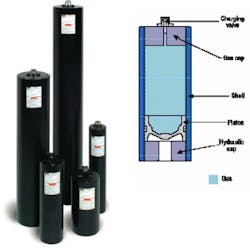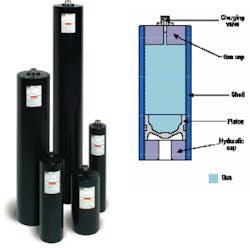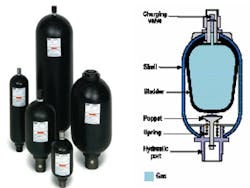Hydropneumatic accumulators are widely used to supplement pump flow, provide auxiliary power, suppress shock, reduce piston pump pulsations, and compensate for internal leaks. Beyond these basic functions, accumulators are used to save energy, reduce equipment costs, lower operating expenses, and prolong equipment life.
Once you’ve decided to capitalize on some of the many benefits offered by accumulators for the hydraulic system you’re designing, the question becomes, should you go with a piston or a bladder design? Surprisingly, for the greatest percentage of applications, it doesn’t matter. However, a bladder is preferable in certain types of applications, whereas a piston type is preferable in others.
Both types at a glance
Piston accumulators consist of a cylindrical body, sealed by a gas cap and charging valve at the gas end, and a hydraulic cap at the hydraulic end. A lightweight piston separates the gas side of the accumulator from the hydraulic side. This design offers high efficiency and flexibility in most applications due to a very wide range of sizes. Application advantages include:
• extremely high flow rates,
• tolerance of temperature extremes,
• high compression ratios,
• ability to withstand external forces,
• unlimited sizes/mounting, and
• ability to work with gas bottles.
Bladder accumulators feature a non-pleated, flexible rubber bladder housed within a steel shell. The open end of the bladder is attached to the pre-charging valve at the gas end of the shell. A poppet valve prevents the bladder from extruding through the hydraulic port.
Application advantages include:
• universal application,
• high tolerance for contamination,
• quick response, and
• ability to work well with water and other low lubricity fluids.
Compression ratios
Compression ratios differ among bladder and piston accumulators. In a bladder accumulator, the compression ratio can be no greater than 4:1. Yet for a piston accumulator it can be 10:1. The difference is that beyond a 4:1 ratio, the bladder will crush itself to the point of damage. Higher pressures simply moves the piston further along the along the accumulator’s bore, rather than pushing it against the inner surface of the accumulator shell. As such, a major reason to choose a piston over a bladder accumulator is when compression ratio will exceed 4:1. If compression ratio will not exceed 4:1, either type of accumulator should suffice.
Piston pros and cons
High flow rates — The majority of bladder accumulators have a capacity of 2½ to 15 gal, with a maximum flow rate of 220 gpm. Anything greater than that can potentially damage the bladder.
Piston accumulators can accommodate flow rates at a comparable size to a bladder unit up to 818 gpm. The maximum velocity for accumulator’s piston is 120-in./sec. All piston flow rates are based on piston speeds of 120 in./sec. If a system requires a flow rate in excess of 220 gpm, the only option is a piston unit.
Extreme low or high temperatures — Bladders are made of rubber and designed to work much like a balloon. The bladders are made of rubber compounds to meet different operational temperature requirements from –40° F to 250° F. Piston units, depending on the type of seal used, have an application temperature range of –45° F to 320° F. If an application requires a temperature below –40° F, or higher than 250° F, a piston unit is the only choice.
Gradual failure — Bladder failures are sudden and allow the stored nitrogen gas to enter the system. When using a bladder accumulator, you must account for the potential of the gas precharge being expelled into the hydraulic system. The question to ask is, “Where will the gas go, and what consequences will result?”
Piston accumulators, because of their small seal, fail gradually. Thus, even when the unit fails, the migration of gas from the gas side to the fluid side is slow. If a system cannot tolerate the potential of an immediate and rapid infusion of gas, then you must use a piston accumulator.
Unlimited size — Piston accumulators capacities can range from 5 in.3 to more than 100 gal. However, bladder accumulator sizes were set by the industry many years ago. For example, no size exists between a 5- and 10-gal unit. Nor is there an option between a 2½- or a 5-gal unit. If your system only requires a 3-gal accumulator, industry standards require you to specify a 5-gal bladder accumulator.
Piston accumulators, on the other hand, can be produced in any size. Large-bore piston accumulators are widely used in applications involving a tremendous amount of energy, and piston accumulators can be designed for working pressures in excess of 10,000 psi. Parker’s piston accumulator bores range from 1½ to 25 in.
A position sensor can be incorporated into piston accumulators with bores 4 in. and larger to determine the location of the piston. Knowing the piston location within the operational cycle allows a programmable controller to determine if the precharge is correct. Loss of gas pressure will immediately produce a signal that the piston is not positioned where it should be. Sensors cannot be added to bladder accumulators. The only way to check precharge in a bladder unit is to physically make a gauge reading while there is no system pressure.
Dithering — If a system exhibits a dither, bladder accumulators are the correct choice. Such conditions can cause a piston to cycle rapidly back and forth in a distance less than its seal width, which causes heat build-up and subsequent lack of lubrication, which may lead to seal wear and ultimate failure.
Bladder pros and cons
Immediate failure — Some applications might be best served if you know that your accumulator has failed, but you don’t want a gradual piston failure or the cost of a sensor. In such instances, specify a bladder accumulator. You will know if it fails, and you can make a quick and easy bladder replacement.
No piston breakaway — Piston accumulators share the same attribute as a cylinder: when sitting for an extended period of time, the piston will establish a set position. When this happens, it takes more pressure to move the piston than is behind it. For example, a piston accumulator may have a 1000-psi precharge, but to move a set piston may require 1010 psi. For high-pressure applications, such a small difference is not important. But, if you have a low-pressure application in the 130- to 150-psi range, a 10-psi breakaway is significant as a percentage of full pressure. If this is a concern for a low-pressure application, it’s best to specify a bladder accumulator.
Maintenance, downtime, and contamination tolerance — If contamination, such as wear particles, get into a bladder accumulator, it is easy to clean. It’s also easy to install a new bladder, if necessary. However, if contamination gets into a piston accumulator and scores the bore deep enough, the accumulator is no longer serviceable. So a bladder accumulator could be specified for piece of mind and ease of repair.
Lighter weight — By design, bladder accumulators are lighter than piston accumulators are. For example: a 15-gal piston accumulator rated at 3000 psi weighs about 500 lb. A bladder accumulator of equal rating weighs 300 lb. When machine weight is important, and all other specifications are met, use a bladder accumulator.
Ed Godin is Technical Services Manager, Parker Hannifin Corp., Global Accumulator Div., Rockford, Ill. For information, contact Parker’s, Global Accumulator Div. at (815) 636-4100 or e-mail [email protected].
About the Author

Leaders relevant to this article:


